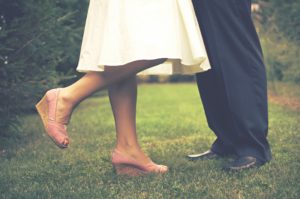It may be our best kept physical therapy secret
to ease muscle tension and decrease pain. It may
also be the easiest change you can make to maintain an
active and healthy lifestyle. And it has to do with your
footwear.
Are you interested in a “quick fix” to protect your joints,
limit break down, and decrease stiffness?
Do you want to continue to exercise for years to come
with less pain?
In order to move, exercise, work, and live without pain,
you need to have your all your joints aligned. . . from your
feet, ankles, knees, hips, back.
In order to change your joint positioning, you must start
at the feet. You do this by changing the inside of your shoes.
Most shoes offer little or no support or protection for your
joints. But just like the foundation of your house, your feet
are the foundation of your body.
You know a house with a poor foundation will not withstand
wear and tear and you would expect future structural
problems. The same is true for your body. A faulty
foundation can result in many foot problems. In fact,
you have over 30 joints in each foot that degenerate with
age. Additional foot ailments include:
- Bunions
- Hammer toe
- Plantar fasciitis
- Morton’s Neuroma
The more pronounced, and less widely realized problems
occur in places other than the feet. A misaligned and
poorly supported foot can result in:
- knee pain due to incorrect movement of the knee cap
- early onset of arthritis
- problems with the hips and pelvis
- persistent back pain
- shoulder or neck pain if the problem is longstanding
So how do you improve your foundation and decrease the
risk you will experience these problems?
We suggest orthotic inserts added to your regular shoes.
Let’s talk about why an orthotic actually does help, and
why not just any “insert” will do.
What does an orthotic do?
An effective orthotic changes the way your foot reacts
during the walking cycle. They are often used to limit
motion such as excessive pronation (rolling in) or
supination (rolling out).
It is much more than an “arch support,” it realigns the
structure of the foot and lower leg. This prevents
misalignment of muscles, tendons, and ligaments.
So what?
Misalignment leads to premature fatigue and pain. As
your foot rests on a properly constructed orthotic, it is
gently and consistently directed into the correct
position for walking, running, and standing.
Why not buy drug store orthotics “off the shelf”?
Everyone’s feet and body type are very different. The
aches and pain you experience when standing or walking
are varying as well. Thus, a product needs to be chosen
carefully based on your body and with the end result in
mind.
In addition, orthotics must have some rigidity because the
point is to provide support for the foot and other joints
throughout your body. Soft flexible material will collapse
and although they may offer temporary “comfort” due to
cushioning, your symptoms will persist.
Will orthotics really make a difference?
Addressing your feet is not so glamorous, but very
important to your health and active lifestyle.
One example . . Jack Nicklaus tells us that in golf
“all timing, distance and direction comes
out of the lower body with the feet
leading the way”
An appropriate orthotic will make a significant difference
in your current pain and performance. Furthermore, it
will undoubtedly prevent future (ore premature) joint
breakdown.
Back to the golf example – a study found that an addition
of a correctly prescribed foot orthotic was associated with
3-5 mpg increase in club head velocity among experienced
golfers. Hence, orthotics may be a very important piece to
your healthy aging puzzle – from your toes all the way up
to your swing.
In conclusion, orthotics are just one piece of a
complex puzzle. To truly improve the way you stand,
walk, run, or swing you need to address strength, posture,
footwear, and movement patterns. In addition to these
things, the orthotics will adjust your biomechanics.
If your movement, stamina, or sports performance are
limited by pain or stiffness, let’s discuss how orthotics can
play a role in improving your alignment and motion.
Inquire HERE today about our prescription orthotics or
talk to one of our therapists about your concerns.




